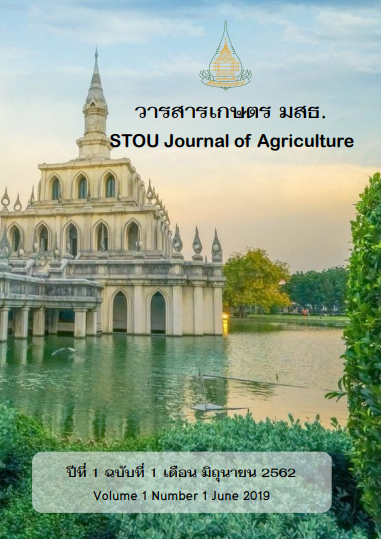สารพฤกษเคมีและสมบัติการต้านอนุมูลอิสระในใบขลู่ตากแห้งของชุมชนบ้านคลองตำหรุ ชลบุรี
Main Article Content
บทคัดย่อ
กลุ่มภูมิปัญญาชายฝั่งทะเล ตำบลคลองตำหรุ อำเภอเมือง จังหวัดชลบุรี นำใบของต้นขลู่ (Pluchea indica (L.) Less) ซึ่งเป็นพืชที่มีกระจายอยู่ทั่วไปในท้องถิ่นมาผลิตเป็นผลิตภัณฑ์ใบขลู่แห้งเพื่อบริโภคในรูปแบบของชาใบ ซึ่งอ้างถึงเฉพาะสรรพคุณตามภูมิปัญญาที่สืบทอดต่อกันมา คือ ช่วยลดความดันโลหิต ขับเหงื่อ ขับปัสสาวะ ล้างพิษ เป็นต้น ในการยกระดับผลิตภัณฑ์จำเป็นต้องมีข้อมูลเชิงวิชาการสนับสนุนเพื่อเสริมสร้างความมั่นใจให้กับผู้บริโภค จึงทำการตรวจสอบสารพฤกษเคมีและสมบัติการต้านอนุมูลอิสระของสารสกัดหยาบจากใบขลู่ตากแห้งที่ชุมชนผลิตขึ้น พบว่า ในสารสกัดหยาบด้วยเอทานอล 95% ตรวจพบสารแทนนิน (tannin) คูมารินส์ (coumarins) แอลคาลอยด์ (alkaloids) คาร์ดิแอค ไกลโคไซด์ (cardiac glycoside) และสเตอรอยด์ (steroid) และพบว่ามีฤทธิ์ในการต้านอนุมูลอิสระ (% DPPH free radical inhibition) ที่ระดับความเข้มข้น 116.98 ± 2.18 µg/mL ดังนั้นอาจกล่าวได้ว่า ผลิตภัณฑ์ใบขลู่ตากแห้งของชุมชนมีสารให้ความหอมคล้ายชาเขียว มีสารต้านอนุมูลอิสระ และมีสรรพคุณกระตุ้นการบีบตัวของหัวใจ ลดคอเลสเตอรอล บรรเทาอาการท้องเสีย แต่มีข้อควรระวังคือ ไม่บริโภคมากจนเกินไป เด็ก สตรีมีครรภ์ และสตรีที่อยู่ในภาวะให้นมบุตรไม่ควรบริโภค
Article Details
บทความที่ได้รับการตีพิมพ์เป็นลิขสิทธฺ์ของวารสารเกษตร มสธ.
ข้อความที่ปรากฎใน
เอกสารอ้างอิง
ชานนท์ นัยจิตร และอนุรักษ์ เชื้อมั่ง. (2559). การประเมินฤทธิ์ต้านอนุมูลอิสระ สารประกอบรวมฟีนอล และนิโคตินของสมุนไพรไย 15 ชนิด. วารสารวิทยาศาสตร์และเทคโนโลยี, 24(2), 351-361.
ไชยรัตน์ ส้มฉุน. (2555). ม.เกษตรฯเจ๋ง ใช้สารบราสสิโนสฯ เร่งข้าวอนุพันธุ์ใหม่ให้เพิ่มผลผลิต. สืบค้นจาก: http://www.thairath. co.th/content/300239.
ณัฏฐพัชร ชัยปกรณ์วงศ์. (2561). สเตอรอยด์จากพืช (ต้นกำเนิด วิตามินดี). สืบค้นจาก: http://www. nutrition-talk.com/steroids/
นพพล เกตุประสาท. (ม.ป.ป.). ขลู่. หน่วยอนุรักษ์และใช้ประโยชน์พืชพรรณ ศูนย์ปฏิบัติการวิจัยและเรือนปลูกพืชทดลอง มหาวิทยาลัยเกษตรศาสตร์กำแพงแสน. สืบค้นจาก: http://clcg.agri.kps.ku.ac.th/ resources/herb/ pluchea.html
นันท์ชนก นันทะไชย อินทิรา ลิจันทร์พร และปาลิตา ตั้งอนุรัตน์. (2556). ความสามารถในการต้านอนุมูลอิสระของชาชงจากเปลือกส้มโอ. คณะเทคโนโลยีการเกษตร มหาวิทยาลัยเทคโนโลยีราชมงคลธัญบุรี.
นิรนาม. (2562). สืบค้นจาก: http://doi.nrct.go.th/ListDoi/Download/353901/a9c94a95a34ada 3582099634edc8c850?
นิศารัตน์ ศิริวัฒนเมธานนท์. (ม.ป.ป.). ผลของสารฝาดในใบชาต่อสุขภาพแม่และเด็ก. กรุงเทพฯ: ภาควิชาเภสัชพฤกษศาสตร์ คณะเภสัชศาสตร์ มหาวิทยาลัยมหิดล.
บุษราคัม สิงห์ชัย จันทร์จิรา ขอจุลซ้วน และปาริฉัตร ด้วงทอง. (2560). พฤกษเคมีและฤทธิ์ทางชีวภาพของชาเล็บรอก. วารสารวิทยาศาสตร์และเทคโนโลยี, 25(5), 830-838.
พิมพ์เพ็ญ พรเฉลิมพงศ์ และนิธิยา รัตนาปนนท์. (ม.ป.ป.). Antinutritional Factor. สืบค้นจาก: http://www.food networksolution.com/wiki/word/4460/antinutritional-factor.
วัชราภรณ์ ประภาสะโนบล. (2561). ฤทธิ์ทางชีวภาพและการตรวจสารพฤกษเคมีเบื้องต้นของรากสิบสองราศี. วารสารวิชาการ วิทยาศาสตร์และเทคโนโลยี มหาวิทยาลัยราชภัฏนครสวรรค์, 10(11), 89-100.
ศูนย์ศึกษาเรียนรู้ระบบนิเวศป่าชายเลนสิรินาถราชินี. (2561). สืบค้นจาก: https://www.facebook.com/ SirinartCenter/posts/1561874980560993/.
อภัย ราษฎรวิจิตร. (ม.ป.ป.). ไฟโตสเตอรอล (Phytosterols). สืบค้นจาก: http://haamor.com/th/ไฟโตสเตอรอล/.
อภิสิทธิ์ อ้วนวงษ์ วันชัย โคตะมี และสุชาดา มานอก. (2559). การตรวจสอบองค์ประกอบทางพฤกษเคมีของสารกลุ่มคาร์ดิแอคไกลโคไซด์และแอลคาลอยด์จากสารสกัดเอทานอลและสารสกัดน้ำของยาหอมเทพจิตร. ก้าวทันโลกวิทยาศาสตร์, 16(2), 87-104.
ออมบุญ ล้วนรัตน์. (2536). การสกัดและตรวจสอบสาระสำคัญจากผลิตภัณฑ์ธรรมชาติ. กรุงเทพฯ: คณะเภสัชศาสตร์ มหาวิทยาลัยมหิดล.
เอนก หาลี และบุณยกฤต รัตนพันธุ์. (2560). การศึกษาประสิทธิภาพในการต้านอนุมูลอิสระจากพืชผักสมุนไพรพื้นบ้าน 15 ชนิด. วารสารวิจัยและพัฒนา มจธ, 40(2), 283-293.
Khan, Z.I., Ahmad, K., Zafar, A., Bashir, H., Hussain, A., Huma, Z., Shad, H.A., Sher, M., Hussain, G., Noorka, I.R., Akram, N.A., & Ashraf, M. (2015). Assessment of poisonous and anti-nutritional compounds in wild edible forages consumed by ruminant species. Journal of Environmental Science and Technology, 8(3), 91-101.
Matos, M.J., Santana, L., Uriarte, E., & Abreu, O. (2015). Coumarins- An important class of phytochemicals. In Phytochemicals – Isolation, Characterisation and Role in Human Health. Chapter 5. Venketeshwer eds. London: In Tech. pp 113-140.
Matsuura, H.N. & Fett-Neto, A.G. (2015). Plant alkaloids: main features, toxicity, and mechanisms of action. In Plant Toxins. Springer Netherlands, pp. 243-261.
Medthai. (2017). 12 ประโยชน์ของสารต้านอนุมูลอิสระ (Antioxidant). สืบค้นจาก: https://medthai. com/สารต้านอนุมูลอิสระ/.
Pobpad. (ม.ป.ป.). สารต้านอนุมูลอิสระ ประโยชน์ต่อสุขภาพและผิวพรรณ. สืบค้นจาก: https://www.pobpad.com/สารต้านอนุมูลอิสระ-ประโยชน์
Srimoon, R., & Ngiewthaisong, S. (2015). Antioxidant and antibacterial activities of Indian Marsh Fleabane (Pluchea indica (L.) Less). KKU Res. J, 20(2), 144-154.
Yang, Z., Kinoshita, T., Tanida, A., Sayama, H., Morita, A. & Watanabe, N. (n.d.). Analysis of coumarin and its precursor in green tea. Retrieved from https://shizuoka.repo.nii.ac.jp/?action=repository...1... Shizuoka University


